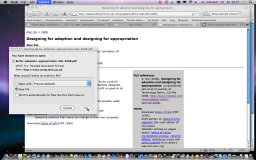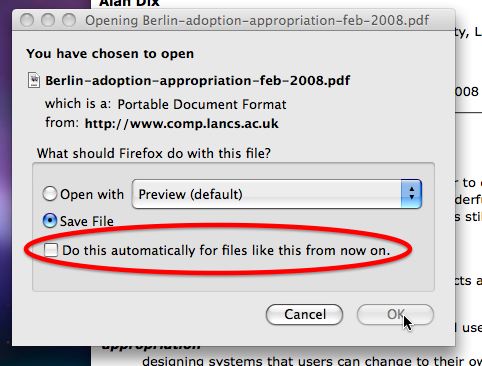I’m wondering why people break things when they create new versions.
Firefox used to open a discreet little window when you downloaded papers. Now-a-days it opens a full screen window completely hiding the browser.
A minor issue, but makes me wonder about both new versions and also defaults and personalisation in general.
This is what Firefox does:
 |
 |
| downoad file from link | oops where’s the screen |
There must be a setting somewhere in the code with the width and height, and someone must have explicitly decided to make it full screen, but why? In order to change it, then there must have been a deliberate decision, but if there is a default value and you aren’t sure what it will be, then why not let the user decide. I resize it every time down to a little discreet window again … I wish it would remember?
It is a little thing, but so often there are arbitrary changes between versions, some major (like the radical XP/Vista that kept many Windows users on the old version), some tiny (but annoying). It may well be that for some people the new behaviour is better, but typically these cosmetic changes are arbitrary, and if so would be obvious things for user preferences, or even alternative skins.
I was in Trento in May talking with Silvia Gabrielli and Anthony Jameson at the Intelligent Interfaces & Interaction group at FBK. They are working on preference and profile setting1, which seems like a problem that should have been solved years ago, but as is evident, is still a very live topic. So few users actually update the user defaults, and as is evident from the Firefox example, many things that should be updateable are not.
One of the simple design heuristics for preferences is to allow them to be set when the user is actually using the feature, not in some separate preference panel. In fact Firefox is quite good at this, for example, with “do this from now on” type options in dialogue boxes. The download window size should also follow this heuristics, so that when I resize the window then next time it should be the same size as I resized it to.
 |
| Firefox doing it right |
Being a little more radical, but hardly complicated, one could adopt one of the design guidelines for appropriation2 and try to make customisation options shareable. This would mean that if I had worked out a nice set of values for preferences I could export it as something like an XML file and mail it to a colleague. Or when you have a new computer you could transfer settings across between applications.
One of the general heuristics that applies also to user customisation is “if you want people to do something, make it easy” … but this applies equally to the developers of customisable parts of an interface.
My guess is that to get things right in the long run the kind of user studies and theoretical work that Tony and Silvia are doing, and design heuristics such as those I’ve mentioned, need to be built into a customisation infrastructure that is both flexible enough for complex parts of an interface (e.g. the password and cookie managers), but also simple enough that it is almost as easy to allow user customisation as it is to fix parameters to an arbitrary value.
- They have a paper at Interact, “Users’ preferences regarding intelligent user interfaces: differences among users and changes over time“[back]
- A. Dix (2007). Designing for Appropriation. In Procedings of BCS HCI 2007, People and Computers XXI, Volume 2, BCS eWiC. paper @ eWiC[back]
Whatever happened to “open containing folder?” Was that a windows xp only option for a specific version?
On “new tab” you used to be able to have it load your homepage instead of being blank, very useful but now depreciated due to a bug I believe – although the option remained in about:config until Firefox 3.0.
Finally, I’d like the download box to close if I’m downloading to open but stay open if I’ve selected to save link as…
For me (Firefox 3.0.11, Mac OS 10.5.7) I do get “open containing folder”, but it is called “Show in Finder” and you need to control click the name in the downloads window list.